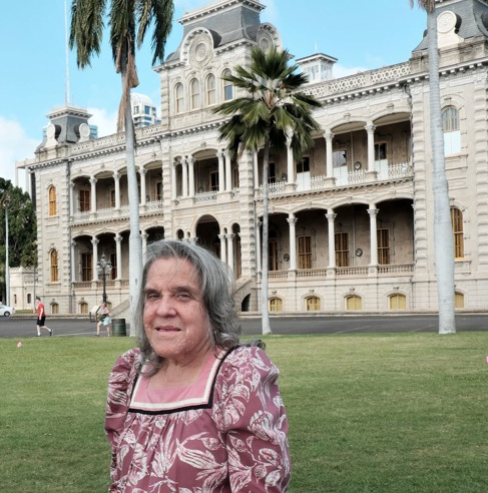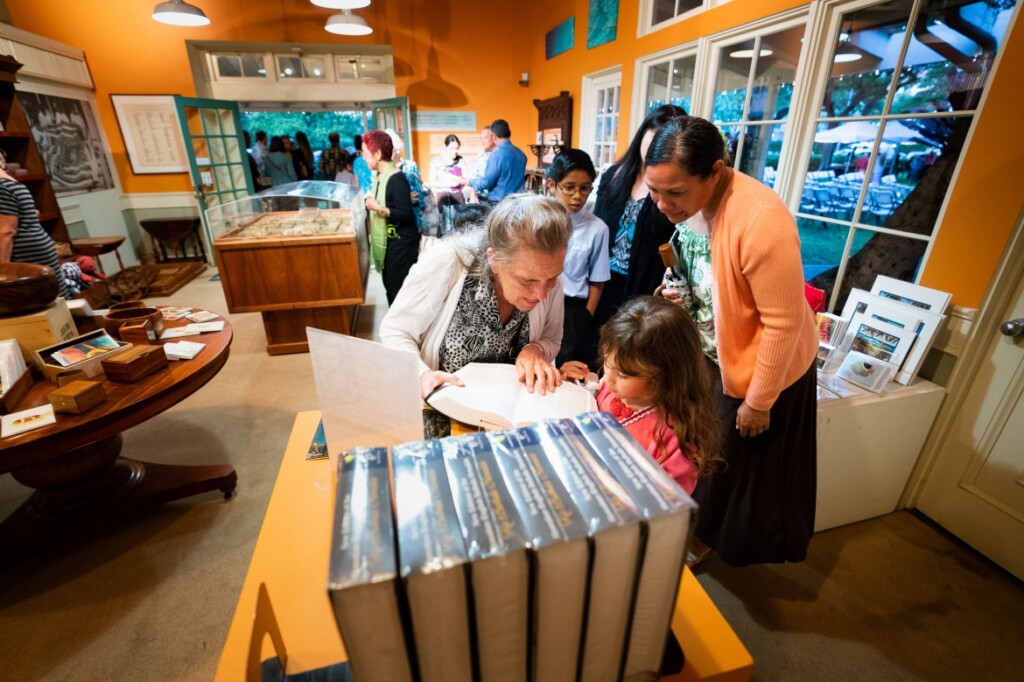
Historian Zita Cup Choy (image @SoundCloud)
Competent and unflappable aptly describe Zita Cup Choy. Her interest in history began in childhood and has fueled her nearly 45 year-career in research and education at Iolani Palace and Washington Place. Zita has helped lead and develop countless exhibits, tours, media presentations, and training classes. Her command of research, documentation and recovery of knowledge is well-respected among her colleagues and peers. She has also contributed to the recovery of royal possessions.
After chatting with her for this interview, I also formed the impression that for Zita, learning and sharing knowledge almost come as naturally to her as breathing! While the pride she has for her work is apparent, her personable, not-on-a-pedestal approach is what distinguishes her. The historical narrative she maintains at both the Palace and Washington Place are accessible and relevant to her audience. Zita deftly bridges professional standards with great storytelling.
HHF: How did you become involved with the Friends of Iolani Palace and Washington Place? How did it lead to your current role?
ZCC: I was recruited by the Friends via a letter they sent to every O‘ahu Hawaiian Civic Club and signed up to train to become a docent in 1977, the year before the Palace opened. Jim Bartels, the curator at the time, trained us. He continued to be involved in docent training until he was hired by Mrs. Cayetano to work at Washington Place. In 2000, Jim needed docents for Washington Place and figuring he would not need to teach Palace docents about the monarchy period or public speaking/customer service skills, he recruited Palace docents to become docents at Washington Place, with a clear understanding we were not to leave the Palace to volunteer for him at Washington Place. Most of my volunteer work for Washington Place is research. I was a volunteer for the Friends from 1977 until 2003, when my former employer JCPenney left the Hawai‘i market. Because of my years of service and because I’d been on a volunteer advisory committee who met to discuss docent and guardian training, I was a contract hire to conduct the 2003 docent class. That contract was renewed and I was shifted from contact hire to staff in 2004. For three years I was a part-time docent educator and a part-time museum registrar. In 2007, I became the full-time docent educator. My position included new docent training, ongoing training and working with the volunteer coordinator to train and/or provide information materials to all volunteers and new staff. Because of my knowledge of the 19th century palace and my years of affiliation, in 2014, I was given the additional title of Historian. I am the go-to person for information about both time periods. I continue to do tours when docents are absent, for the media and for tours by special request. Before COVID, I was slated to be a guest speaker instead of a co-teacher for the 2020 docent classes; reduction in staffing means I will be doing the training again.
HHF: Your position involves meeting dignitaries and people from all over the world. Please share one or two stories of your most memorable experiences.
ZCC: Decades ago, I was doing a tour for a group of Boy Scouts (middle school age) from Maui. I almost tripped over them each time I turned around, they were following me so closely. They asked wonderful questions, such as, “Where did the king keep his canoe and surfboard?”

Zita Cup Choy (left) reads the new edition of the Ka Baibalaa with a young girl and her mother as part of a celebration of the bilingual Bible’s release at Mission Houses Museum in 2018 (courtesy Kamehameha Schools).
HHF: What has been the most gratifying part of your work?
ZCC: My favorite task is answering questions. Questions that need to have information in my hard copy and digital files pulled together and questions that might need a little bit of additional research.
HHF: Standards of historical interpretation evolve with time. What are the standards you maintain at Iolani Palace?
ZCC: From the time we opened, we have been expected to be accurate, balanced, and respectful. When new information is found, stories that we share with the public in any and all formats must change. In 1990, one of our volunteers visited Buckingham Place and was told their electric lights were installed during the reign of Edward VII (1901-1910). Our narrative back then was we (Iolani Palace) had electric lights four years before the White House and 20 years before Buckingham Palace.
Subsequently in 2007, our curator found on an official British monarchy website that Buckingham Palace’s electric lights were installed between 1882 and 1887. Now our story is: the Palace had electric lights four years before the White House and around the same time as Buckingham Palace. Just think, (Queen) Kapiolani might have seen electric lights when she met Queen Victoria in Buckingham Palace in 1887.
Zita Cup Choy will be recognized with a Preservation Award for Individual Achievement at the 2021 Preservation Honor Awards Virtual Ceremony on May 21st. Click here for further information.
By Beth Iwata, Director of Development, Historic Hawai‘i Foundation
This video tour prepared for American History TV is a great example of Zita’s work.
Iolani Palace is open for tours and provides a variety of online resources and virtual presentations. Visit the Palace website for details.

